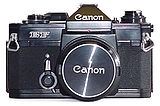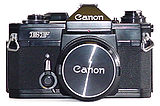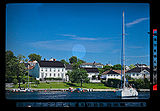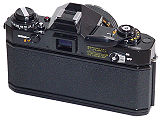
Canon EF camera
Encyclopedia
This article is about an FD-mount 35mm SLR camera from the 1970s. For Canon's electrical autofocus lens mount introduced in the EOS series, see Canon EF lens mount
.
 The Canon EF is a manual focus 35mm
The Canon EF is a manual focus 35mm
single-lens reflex camera
produced by Canon
between 1973 and 1978. It was compatible with Canon's FD-mount
lenses. The EF was built as an electronic version of Canon's top-of-the line F-1 camera. Because of this, the EF shares the F-1's rugged construction and tough metal body. Unlike the F-1, the EF doesn't support any motor drive for film transport.
The Canon EF contained a silicon
photocell light meter
with a range of EV
18 to EV -2 which measured light in a "central emphasis metering" pattern (also called center weighted average metering) with less influence from the top of the frame, to minimize underexposure due to a bright skyline. Note that this requires the camera to be held horizontally; taking vertically oriented pictures requires some care by the user. The Canon EF could operate "Variable Aperture AE" mode (commonly called shutter priority
) or full manual mode, where the operator would control both the shutter
speed and the aperture
. When used in automatic mode, it's possible to lock the current aperture
value, then recompose the picture, if desired.
Automatic exposure required the FD-mount
lenses. In 1975, the range of FD lenses
available spanned from 15 mm fisheye
to 300 mm telephoto, including three zoom lens
es. Using manual exposure and stopped down metering, the Canon EF could also be used with the older FL-mount
and R-mount lenses.
The EF used a unique shutter among Canon's 35mm SLRs: a Copal Square vertical-travel metal blade focal plane shutter. Unusually, long exposures (from 1 second to 30 seconds) were electronically controlled, while shorter ones (1/1000 second to 1/2 second) were mechanically controlled. This was very useful in conserving battery power, and allowed one to use the camera even with dead batteries. The light metering system's power switch turned on the meter, removed the lock from the shutter trigger button and let the film advance lever pop out 15 degrees from the camera body, all in one flick of the thumb.
In the axis of the main switch, a multiple exposure button is located. Pressing this while cocking the shutter prevents advancing the film. The frame counter is also blocked, thus preserving the correct frame count.
At the time, most cameras didn't support longer exposure times than about one second, without having to use the bulb setting. Maybe this was why Canon placed a red LED to the left of the pentaprism, and had the LED flashing as long as the electronic shutter timer was running. The LED was also used for battery check.
 The focusing screen
The focusing screen
of the Canon EF cannot be replaced by the user. Early models feature a microprism circle, the later a split image screen with a microprism ring around it.
Powering the electro-mechanical shutter and light meter were two PX 625 1.35 volt
mercury
batteries
.
The EF is the only camera in the manual focus Canon line of the 1960s and 1970s (which includes the FTb, the F-1, and the FT) that can be used with common 1.5 volt batteries without modification to the internal electronics.
Like all pre-1987 Canon SLR's, the EF accepted Canon FD
mount lenses. The shutter speed
range was 1/1000 of a second to 30 seconds (the 15 & 30 second settings actually give 16 and 32 seconds, thus preserving the doubling sequence), plus bulb
. The X-sync was 1/125th of a second. The camera included setting for film speed
s of 12 ASA
to 3200 ASA.
The EF also featured a self-timer and a stop-down metering mode which could also be used for depth-of-field preview. Stopped down metering must be used with older Canon FL
lenses. The mirror can also be locked up for long exposures, to minimise camera shake.
Canon EF lens mount
Introduced in 1987, the EF lens mount is the standard lens mount on the Canon EOS family of SLR film and digital cameras. EF stands for "Electro-Focus": automatic focusing on EF lenses is handled by a dedicated electric motor built into the lens...
.

135 film
The term 135 was introduced by Kodak in 1934 as a designation for cartridge film wide, specifically for still photography. It quickly grew in popularity, surpassing 120 film by the late 1960s to become the most popular photographic film format...
single-lens reflex camera
Camera
A camera is a device that records and stores images. These images may be still photographs or moving images such as videos or movies. The term camera comes from the camera obscura , an early mechanism for projecting images...
produced by Canon
Canon Inc.
is a Japanese multinational corporation that specialises in the manufacture of imaging and optical products, including cameras, camcorders, photocopiers, steppers and computer printers. Its headquarters are located in Ōta, Tokyo, Japan.-Origins:...
between 1973 and 1978. It was compatible with Canon's FD-mount
Canon FD
The Canon FD lens mount is a physical standard for connecting a photographic lens to a single-lens reflex camera body. The standard was developed by Canon of Japan and was introduced in March 1971 with the Canon F-1 camera. It was the primary Canon SLR lens mounting system until 1987 when the...
lenses. The EF was built as an electronic version of Canon's top-of-the line F-1 camera. Because of this, the EF shares the F-1's rugged construction and tough metal body. Unlike the F-1, the EF doesn't support any motor drive for film transport.
The Canon EF contained a silicon
Silicon
Silicon is a chemical element with the symbol Si and atomic number 14. A tetravalent metalloid, it is less reactive than its chemical analog carbon, the nonmetal directly above it in the periodic table, but more reactive than germanium, the metalloid directly below it in the table...
photocell light meter
Light meter
A light meter is a device used to measure the amount of light. In photography, a light meter is often used to determine the proper exposure for a photograph...
with a range of EV
Exposure value
In photography, exposure value denotes all combinations of a camera's shutter speed and relative aperture that give the same exposure. In an attempt to simplify choosing among combinations of equivalent camera settings, the concept was developed by the German shutter manufacturer in the 1950s...
18 to EV -2 which measured light in a "central emphasis metering" pattern (also called center weighted average metering) with less influence from the top of the frame, to minimize underexposure due to a bright skyline. Note that this requires the camera to be held horizontally; taking vertically oriented pictures requires some care by the user. The Canon EF could operate "Variable Aperture AE" mode (commonly called shutter priority
Shutter priority
Shutter priority refers to a setting on some cameras that allows the user to choose a specific shutter speed while the camera adjusts the aperture to ensure correct exposure...
) or full manual mode, where the operator would control both the shutter
Shutter (photography)
In photography, a shutter is a device that allows light to pass for a determined period of time, for the purpose of exposing photographic film or a light-sensitive electronic sensor to light to capture a permanent image of a scene...
speed and the aperture
Aperture
In optics, an aperture is a hole or an opening through which light travels. More specifically, the aperture of an optical system is the opening that determines the cone angle of a bundle of rays that come to a focus in the image plane. The aperture determines how collimated the admitted rays are,...
. When used in automatic mode, it's possible to lock the current aperture
Aperture
In optics, an aperture is a hole or an opening through which light travels. More specifically, the aperture of an optical system is the opening that determines the cone angle of a bundle of rays that come to a focus in the image plane. The aperture determines how collimated the admitted rays are,...
value, then recompose the picture, if desired.
Automatic exposure required the FD-mount
Canon FD
The Canon FD lens mount is a physical standard for connecting a photographic lens to a single-lens reflex camera body. The standard was developed by Canon of Japan and was introduced in March 1971 with the Canon F-1 camera. It was the primary Canon SLR lens mounting system until 1987 when the...
lenses. In 1975, the range of FD lenses
Canon FD
The Canon FD lens mount is a physical standard for connecting a photographic lens to a single-lens reflex camera body. The standard was developed by Canon of Japan and was introduced in March 1971 with the Canon F-1 camera. It was the primary Canon SLR lens mounting system until 1987 when the...
available spanned from 15 mm fisheye
Fisheye
Fisheye may refer to:* The eye of a fish or other aquatic creature resembling a fish* Fisheye lens, used in photography* Fisheye, a character from the anime Sailor Moon* FishEye , a revision control browser by Atlassian Software Systems...
to 300 mm telephoto, including three zoom lens
Zoom lens
A zoom lens is a mechanical assembly of lens elements for which the focal length can be varied, as opposed to a fixed focal length lens...
es. Using manual exposure and stopped down metering, the Canon EF could also be used with the older FL-mount
Canon FL
Canon FL refers to a lens mount standard for 35mm single-lens reflex cameras from Canon. It was introduced in April 1964 with the Canon FX camera, replacing the previous Canon R mount. It was in turn replaced in 1971 by the Canon FD lens mount...
and R-mount lenses.
The EF used a unique shutter among Canon's 35mm SLRs: a Copal Square vertical-travel metal blade focal plane shutter. Unusually, long exposures (from 1 second to 30 seconds) were electronically controlled, while shorter ones (1/1000 second to 1/2 second) were mechanically controlled. This was very useful in conserving battery power, and allowed one to use the camera even with dead batteries. The light metering system's power switch turned on the meter, removed the lock from the shutter trigger button and let the film advance lever pop out 15 degrees from the camera body, all in one flick of the thumb.
In the axis of the main switch, a multiple exposure button is located. Pressing this while cocking the shutter prevents advancing the film. The frame counter is also blocked, thus preserving the correct frame count.
At the time, most cameras didn't support longer exposure times than about one second, without having to use the bulb setting. Maybe this was why Canon placed a red LED to the left of the pentaprism, and had the LED flashing as long as the electronic shutter timer was running. The LED was also used for battery check.

Focusing screen
A focusing screen is a flat translucent material, usually ground glass, found in a system camera that allows the user of the camera to preview the framed image in a viewfinder. Often, focusing screens are available in variants with different etched markings for various purposes...
of the Canon EF cannot be replaced by the user. Early models feature a microprism circle, the later a split image screen with a microprism ring around it.
Powering the electro-mechanical shutter and light meter were two PX 625 1.35 volt
Volt
The volt is the SI derived unit for electric potential, electric potential difference, and electromotive force. The volt is named in honor of the Italian physicist Alessandro Volta , who invented the voltaic pile, possibly the first chemical battery.- Definition :A single volt is defined as the...
mercury
Mercury (element)
Mercury is a chemical element with the symbol Hg and atomic number 80. It is also known as quicksilver or hydrargyrum...
batteries
Battery (electricity)
An electrical battery is one or more electrochemical cells that convert stored chemical energy into electrical energy. Since the invention of the first battery in 1800 by Alessandro Volta and especially since the technically improved Daniell cell in 1836, batteries have become a common power...
.
The EF is the only camera in the manual focus Canon line of the 1960s and 1970s (which includes the FTb, the F-1, and the FT) that can be used with common 1.5 volt batteries without modification to the internal electronics.
Like all pre-1987 Canon SLR's, the EF accepted Canon FD
Canon FD
The Canon FD lens mount is a physical standard for connecting a photographic lens to a single-lens reflex camera body. The standard was developed by Canon of Japan and was introduced in March 1971 with the Canon F-1 camera. It was the primary Canon SLR lens mounting system until 1987 when the...
mount lenses. The shutter speed
Shutter speed
In photography, shutter speed is a common term used to discuss exposure time, the effective length of time a camera's shutter is open....
range was 1/1000 of a second to 30 seconds (the 15 & 30 second settings actually give 16 and 32 seconds, thus preserving the doubling sequence), plus bulb
Bulb (photography)
Bulb, abbreviated B, is a shutter speed setting on an adjustable camera that allows for long exposure times under the direct control of the photographer. With this setting, the shutter simply stays open as long as the shutter release button remains depressed...
. The X-sync was 1/125th of a second. The camera included setting for film speed
Film speed
Film speed is the measure of a photographic film's sensitivity to light, determined by sensitometry and measured on various numerical scales, the most recent being the ISO system....
s of 12 ASA
Film speed
Film speed is the measure of a photographic film's sensitivity to light, determined by sensitometry and measured on various numerical scales, the most recent being the ISO system....
to 3200 ASA.
The EF also featured a self-timer and a stop-down metering mode which could also be used for depth-of-field preview. Stopped down metering must be used with older Canon FL
Canon FL
Canon FL refers to a lens mount standard for 35mm single-lens reflex cameras from Canon. It was introduced in April 1964 with the Canon FX camera, replacing the previous Canon R mount. It was in turn replaced in 1971 by the Canon FD lens mount...
lenses. The mirror can also be locked up for long exposures, to minimise camera shake.


